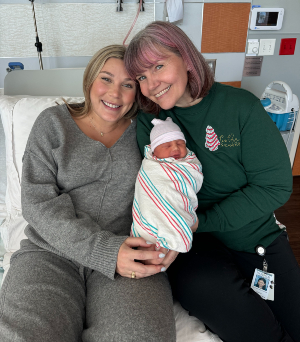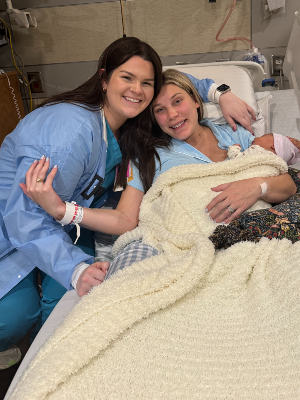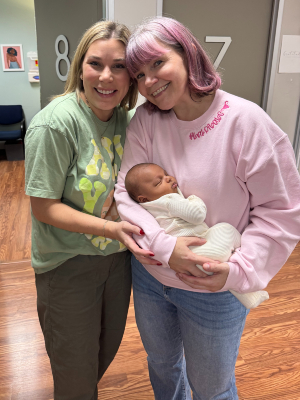 As a Labor and Delivery nurse at Memorial Hermann Katy Hospital, Bianca Allen has guided countless women through some of their most vulnerable, life-changing moments. But when she suddenly became the patient, everything changed. Her journey took an unexpected turn—one that tested her strength, deepened her compassion and reinforced the unbreakable bond between nurses.
As a Labor and Delivery nurse at Memorial Hermann Katy Hospital, Bianca Allen has guided countless women through some of their most vulnerable, life-changing moments. But when she suddenly became the patient, everything changed. Her journey took an unexpected turn—one that tested her strength, deepened her compassion and reinforced the unbreakable bond between nurses.
Despite taking every precaution after her previous postpartum hemorrhages (PPH), Bianca once again faced complications—this time, requiring an emergency hysterectomy to save her life. In those critical moments, her nursing and physician colleagues in Labor and Delivery rallied around her, not just as medical professionals but as family, offering the same compassionate care they provide to their patients.
Now, as a nurse who has experienced this ordeal firsthand, Bianca brings a rare depth of understanding to her role—allowing her to support her patients with both professional experience and compassion.
A Family’s Joy and Anxiety: Welcoming Baby Jack
Bianca and her husband, Triston, were already juggling the joy and excitement of raising their two beautiful daughters, ages 3 and 4, when they discovered they were expecting their third child. "The third one was a surprise for sure," Bianca recalled. "We knew we wanted another one, but we had planned for a little more time in between."
When Bianca saw the positive pregnancy test, her first instinct was to text Bethany Peterson, MD—her OB/GYN affiliated with Memorial Hermann Katy who had guided her through her previous two pregnancies. "I sent her a picture of the test and she responded, 'Oh my gosh.' She was happy for the couple, but one of the first things she said was, 'It’s going to be okay.'"
A History of Postpartum Hemorrhage
Though overjoyed to be expecting baby Jack, Bianca and Triston couldn’t ignore a lingering sense of anxiety. Bianca had experienced PPH—a dangerous, excessive bleeding after childbirth—with both of her previous pregnancies, each requiring medical intervention.
During Bianca’s first pregnancy, she lost 2,500 milliliters of blood and required a massive transfusion, a D&C and a Bakri balloon—a device that applies pressure inside the uterus to control bleeding. Her second pregnancy was similar, with a 1,500-milliliter blood loss and the same interventions. "I just had this pit in my gut that it was going to happen again," she said. "Dr. Peterson kept reassuring me, ‘Every pregnancy is different. This one’s a boy—it could be totally fine.’ But deep down, I knew."
A Prophylactic Birth Plan
As a Labor and Delivery nurse, Bianca had seen firsthand how quickly postpartum hemorrhages could become life-threatening. One case, in particular, left a lasting impression—Bianca was 27 weeks along when she met a patient who experienced a massive hemorrhage, resulting in an emergency hysterectomy and an intensive care unit (ICU) stay.
 “I visited her the next day on my day off, sitting by her side in the ICU, holding her hand as we both cried,” Bianca recalled. “In that moment, it felt as though I was seeing a reflection of my own future. That night, I sat down and created my prophylactic birth plan to anticipate and manage complications before they happened. I told myself, ‘This can’t happen to me. We have to be prepared.’”
“I visited her the next day on my day off, sitting by her side in the ICU, holding her hand as we both cried,” Bianca recalled. “In that moment, it felt as though I was seeing a reflection of my own future. That night, I sat down and created my prophylactic birth plan to anticipate and manage complications before they happened. I told myself, ‘This can’t happen to me. We have to be prepared.’”
Bianca discussed her plan in detail with Dr. Peterson, emphasizing the need for immediate interventions to minimize risks. "Death is always in the delay," Bianca said. "Hemorrhages get out of control when things aren’t anticipated. If we can prevent complications before they escalate, we should be proactive about it."
Bianca’s birth plan focused on preventing severe bleeding with key measures including a second IV line for emergency access, blood readily available in the delivery room, an aggressive postpartum Pitocin protocol to reduce bleeding risks and insertion of a Bakri balloon if blood loss reached 300-400 milliliters—well before the standard hemorrhage threshold of 1,000 milliliters for vaginal delivery.
The Birth of Baby Jack
Bianca stopped working at thirty-four weeks as her blood pressure began to rise, focusing on making it safely to thirty-seven weeks. Her induction was scheduled for Monday, November 18, 2024.
"I was already four centimeters when I arrived at the hospital," Bianca said, with her husband, Triston, by her side. "Everything was great. The birth was the best of all three—smooth and easy. I had an epidural, due to my hemorrhage risks. By 3:30 PM, I was 10 centimeters. Jack was born in one contraction."
Weighing 7 pounds, 11 ounces, Jack was healthy, filling the couple with a huge sense of relief. "Dr. Peterson massaged my uterus and said everything looked great. I even massaged my own uterus, and it felt firm. No bleeding. I remember thinking, ‘This is the one. We did it. We’re good.’"
An Ominous Turn
Despite her history of delayed hemorrhaging—typically around 45 minutes postpartum—Bianca and Dr. Peterson remained vigilant. "We just sat there, chatting, watching, waiting," Bianca recalled. "But I could tell she was getting more and more concerned. She kept massaging my uterus, watching and waiting.”
Then, the bleeding started.
Dr. Peterson acted immediately, inserting the Bakri balloon as outlined in Bianca’s birth plan and administering all uterotonic medications. The bleeding stopped and Bianca was cleaned up and repositioned in bed.
"Everything seemed fine," Bianca said. "Then, out of nowhere, I didn't feel well. I felt dizzy, nauseous and my eyes got heavy. I remember saying, ‘I don’t feel good. I don’t feel good.’ When Dr. Peterson looked at me, I could see in her eyes that she knew something was wrong."
As Bianca’s complexion paled, Dr. Peterson quickly removed the vaginal packing behind the Bakri balloon, which was soaked in blood. She looked at me and said, "We have to go to the OR," and I just replied, "I know." Bianca’s heart sank. Her only request was to stay with her baby and husband, but deep down, she knew there was no choice.
“I thought of my patient who’d needed a hysterectomy. I asked my husband to let me hold Jack for one more moment. I knew going to the OR meant missing the first hours of his life and I hated that.”
Through tears, Bianca kissed her baby boy and braced herself for what lay ahead. In that moment, one of her nurses and dear friends, Becky, approached Bianca and asked if she could pray with her. They held hands and prayed together, their words offering solace and hope in the midst of uncertainty.
A Race Against Time in the OR
As she was wheeled into the OR, Bianca passed familiar faces—her coworkers, her friends—now her caregivers. The silence was heavy, thick with unspoken words. Mark Goldstein, MD, an anesthesiologist affiliated with Memorial Hermann Katy, offered reassurance, but Bianca couldn’t shake the feeling of impending doom. Her nurses, Allie and Sara, whom she called 'rockstars,' stayed with her in the OR the entire time.
 “I remember the bag mask on my face and Dr. Peterson staring at me,” recalled Bianca. “She held my hand as I started counting—heads in the room, ceiling tiles—anything to stay awake and distracted. But I couldn’t shake the feeling that something wasn’t going to be good. I looked at Dr. Goldstein, then pulled Dr. Peterson down and asked her to call Brad Shore, MD, the backup anesthesiologist. It wasn’t about doubting Dr. Goldstein—he’s incredible. But treating someone you know personally in a critical situation like this, it’s hard to separate the emotion from the medicine. I just didn’t want him to be alone in that. I wanted to make sure everyone in that operating room could stay focused, no matter what happened.”
“I remember the bag mask on my face and Dr. Peterson staring at me,” recalled Bianca. “She held my hand as I started counting—heads in the room, ceiling tiles—anything to stay awake and distracted. But I couldn’t shake the feeling that something wasn’t going to be good. I looked at Dr. Goldstein, then pulled Dr. Peterson down and asked her to call Brad Shore, MD, the backup anesthesiologist. It wasn’t about doubting Dr. Goldstein—he’s incredible. But treating someone you know personally in a critical situation like this, it’s hard to separate the emotion from the medicine. I just didn’t want him to be alone in that. I wanted to make sure everyone in that operating room could stay focused, no matter what happened.”
Once Bianca was under anesthesia, her care team immediately began blood transfusions and administered FFP, which contains fibrinogen—a crucial clotting component—to help control the hemorrhaging. With the bleeding persisting, Dr. Peterson removed the Bakri balloon.
"When Dr. Peterson removed it, my uterus was floppy," Bianca later learned. "It should have been firm, like a boulder, but it wasn’t—it was soft and I kept bleeding."
The first Bakri balloon didn’t work, which was concerning since it had worked in Bianca’s previous deliveries. Dr. Peterson placed a second one, hoping for a different outcome, but it too had fallen out, unable to stay in place. Meanwhile Bianca’s blood pressure was dangerously low, which created even more concern and urgency in the OR.
As the team worked to stabilize her, Dr. Peterson called Interventional Radiology, hoping a uterine artery embolization— a procedure that blocks blood vessels supplying the uterus—could stop the bleeding.
Although the hemorrhaging had slowed, something more insidious was unfolding. Dr. Peterson noticed bruising on Bianca’s legs and blood that had begun to thin—signs of Disseminated Intravascular Coagulation (DIC), a life-threatening condition where the body both clots and bleeds uncontrollably.
Dr. Peterson couldn’t wait any longer.
The Hysterectomy: A Life-Saving Decision
As Bianca lay on the operating table, Dr. Peterson had done everything in her power to stop the hemorrhaging. But when it became clear that a hysterectomy was the only option left to save her life, she called in Amina Sayeed, MD—a trusted colleague, friend and OB/GYN affiliated with Memorial Hermann Katy—to assist with the procedure. Together, they performed the surgery, removing Bianca’s uterus and finally stopping the relentless bleeding.
 Surrounded by her care team, Bianca felt the weight of their silence. Then, the aching in her stomach brought her back to reality. She slowly lifted her gown and saw the large dressing on her belly. "I just remember looking at them and saying, 'I don’t have my uterus anymore, do I?'" she said.
Surrounded by her care team, Bianca felt the weight of their silence. Then, the aching in her stomach brought her back to reality. She slowly lifted her gown and saw the large dressing on her belly. "I just remember looking at them and saying, 'I don’t have my uterus anymore, do I?'" she said.
Their response was gentle but firm. "No."
The reality of the hysterectomy hit Bianca in waves—anger, grief, sadness and confusion. “No amount of gratitude can erase the grief,” she admitted. "You grieve the birth you didn’t have, the loss of your uterus, all of it. And even though I’m beyond grateful to be alive, that grief still lingers."
Yet amid the emotions, Bianca focused on her blessings—she was alive, her baby was healthy and she had an incredible team who stood by her.
"Even the best birth plan can’t prepare you for everything," Bianca said. "You know things can go wrong, but when they do, it’s the people in your corner who make the difference between life and death. They act faster than DIC creeping in, they advocate for you and they remove every ounce of emotion in the most emotional hours. They’re your people and they deserve every piece of honorary recognition."